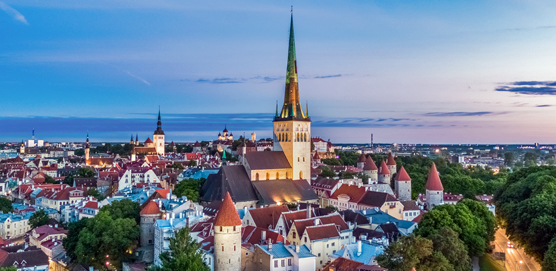GRACE final conference in Tallinn, Estonia 23.-24.5.2019

Old town of Talllinn. Photo: Kaupo Kalda
The Horizon 2020 GRACE project ended in august 2019, and we presented the major findings to all interested stakeholders at this conference, which was open to the public. Also other projects presented their posters at the conference.
Presentations
Introduction to the GRACE project (pdf)Opens in new window. Kirsten S. Jørgensen, Co-ordinator of the GRACE Project, Finnish Environment Institute SYKE, Finland
Oil spill response preparedness in the Baltic Sea (pdf)Opens in new window. Ismo Siikaluoma (Finnish Border Guard, SAR and Maritime Safety Unit, Head of Unit)
Marine Oil Spill Research in Canada (pdf)Opens in new window. Feiyue Wang, Professor (Centre for Earth Observation Science (CEOS) & Department of Environment and Geography, University of Manitoba, Canada)
EPPR/GRACE work on oil spills (pdf)Opens in new window. Jens Peter Holst-Andersen (Commander, Danish Ministry of Defence, Denmark), Chair of the Arctic Council working group on Emergency, Prevention, Preparedness and Response, EPPR)
Tests with in situ burning in Norway (pdf). Hilde Dolva (Senior Advisor, Norwegian Coastal Administration, Norway)
Multi-compartment modelling - a tool to assess exposure of different organism groups to oil components (pdf)Opens in new window. Matthias Grote (Researcher, Federal Institute for Risk Assessment, Germany)
Session I: Oil spill detection, monitoring, fate and distribution
Sensors for in situ oil spill detection – problems and outlook (pdf)Opens in new window. Harri Kankaanpää, (Finnish Environment Institute, SYKE, Finland), Siim Pärt (Tallinn University of Technology, TalTech, Estonia) and Leonie Nüßer (RWTH Aachen University, Germany)
Operational oil spill detection and monitoring on fairways using FerryBox and SmartBuoy technologies (pdf)Opens in new window. Siim Pärt, Tarmo Kõuts, Kaimo Vahter (Tallinn University of Technology, TalTech, Estonia) and Seppo Virtanen (MeriTaito/SeaHow, Finland)
Local scale oil spill modelling and risk assessment in seasonally ice covered seas (pdf)Opens in new window. Urmas Raudsepp, Ilja Maljutenko, Tarmo Kõuts (Tallinn University of Technology, TalTech, Estonia) and Nelly Forsman (SSPA, Sweden)
Strategic view on oil spill response support using in situ and remote sensing data tools (pdf)Opens in new window. Jorma Rytkonen (Finnish Environment Institute, SYKE, Finland), Tarmo Kõuts and Siim Pärt (Tallinn University of Technology, TalTech, Estonia)
Session II: Oil biodegradation and bioremediation
New results on biodegradation of oil and dispersed oil in cold marine environment (pdf)Opens in new window. Ossi Tonteri (Finnish Environment Institute, SYKE, Finland)
Biodegradation of crude oil in seawater and ice-water interface (pdf)Opens in new window. Nga Dang, M. O’ Sadnick, C. Petrich (NORUT Northern Research Institute, Norway), J. Truu, K. Oopkaup, M. Truu (Tartu University, Estonia)
Marine microbial community taxonomic and functional structure and its association with oil exposure and oil biodegradation activity (pdf)Opens in new window. Jaak Truu, Kristjan Oopkaup, Marika Truu (Tartu University, Estonia), Nga P. Dang (NORUT Northern Research Institute, Norway), Ossi Tonteri, Anna Reunamo, Kirsten S. Jørgensen (Finnish Environment Institute, Finland)
Session III: Oil impacts on biota using biomarkers and ecological risks assessment
Field studies and Greenland in situ burning experiment (pdf)Opens in new window. Denis Benito, University of the Basque Country, Bilbao, Spain
Linking molecular event and apical effect to assess oil toxicity in mussels, copepods and zebrafish (pdf)Opens in new window. Aino Ahvo, Finnish Environment Institute SYKE, Helsinki, Finland
An effect-based toolbox for the rapid and cost-effective investigation and fingerprinting of oil contamination (pdf)Opens in new window. Sarah Johann, RWTH Aachen University, Aachen, Germany
Three years research into environmental effects of oil spills and response actions - a wrap-up (pdf)Opens in new window. Thomas-Benjamin Seiler, RWTH Aachen University, Aachen, Germany
Session IV: Combat of oil spill in coastal arctic water - effectiveness and environmental effects
Burning oil on ice (pdf)Opens in new window. Christian Petrich (NORUT Northern Research Institute, Norway) and Janne FrittRasmussen (Department of Bioscience, Aarhus University, Denmark)
Oil recovery under ice project (pdf)Opens in new window. Rune Högström and Markus Nystedt (Lamor, Finland)
In situ burning and effects from oil spills on Arctic shorelines (pdf)Opens in new window. Kim Gustavson, Susse Wegeberg and Janne Fritt-Rasmussen (Department of Bioscience, Aarhus University, Denmark)
Session V: Environment & Oil Spill Response (EOS) - an analytic tool for environmental assessments to support oil spill response design
Environment & Oil Spill Response (EOS) - an analytic tool for environmental assessments to support oil spill response design I. Framework and decision trees (pdf)Opens in new window. Susse Wegeberg, Janne Fritt-Rasmussen and Kim Gustavson (Department of Bioscience, Aarhus University,Denmark)
Operational add-ons to the EOS tool (pdf)Opens in new window. Bjørn Forsman and Nelly Forsman (SSPA, Sweden)
Closing session
Industry efforts in Arctic spill response technology development (pdf)Opens in new window. M. Smit (Chair Environmental Effects Technical Working Group, Arctic Response Technology JIP, International Association of Oil and Gas Producers (IOGP))
Using NEBA and Environmental Risk Methods for Oil Spill Response Planning and Preparedness (pdf)Opens in new window. Richard Wenning (Ramboll US, USA)
More information